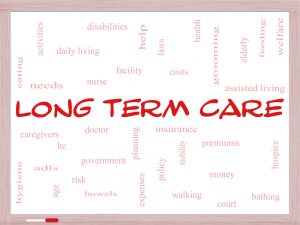Understanding the Potential Long-Term Care Cost for Seniors
 If you’re getting older, you’ve probably thought about what kind of insurance you’ll need to cover health issues and medical expenses, from medications to specific procedures. But in some cases, for chronic conditions, disabilities or illnesses, long-term care will be necessary — whether this means staying in a nursing home, hiring a live-in caretaker or modifying your home to meet your needs.
If you’re getting older, you’ve probably thought about what kind of insurance you’ll need to cover health issues and medical expenses, from medications to specific procedures. But in some cases, for chronic conditions, disabilities or illnesses, long-term care will be necessary — whether this means staying in a nursing home, hiring a live-in caretaker or modifying your home to meet your needs.
However, long-term care cost is not covered by employer-based health care plans, and Medicare only covers some options, like short-term stays in nursing homes. So how can you go about paying for long-term care if it becomes necessary? That’s where long-term care insurance comes in — it’s a particular policy that you can buy which will help pay for the essential expenses, depending on what kind of plan you have and what your specific needs are.
What plans are available?
The first type of long-term care plan is an individual policy, which will vary in price and coverage depending on where you buy it. Just make sure that you’re buying from a licensed insurance agent or broker who has special training in long-term care, if possible.
It’s also possible to get long-term insurance through your employer, which may offer you a group plan or an individual policy at a discounted group rate. One benefit is that your family members might qualify if they pay premiums and pass medical screenings; another is that once you leave your job (for retirement or any other reason), you can keep the policy as long as you continue to pay premiums. You could get a similar offer from a professional or service organization you belong to, so make sure to check with any groups you’re in to see if they have such a membership benefit.
Another possibility is getting long-term care insurance through a State Partnership Program, which would allow you to continue to qualify for Medicaid while also letting you keep your assets. Finally, you can take out a joint policy with a spouse or family member, though this might be limited because of the maximum benefit that applies to total expenditures on long-term care for both people.
What services do they cover?
Long-term care insurance can cover a variety of services, all of which may not be offered in all plans. There could also be restrictions, such as some plans require the care provider to have a specific license or work out of a specific facility, while others will cover care by non-licensed professionals or family members. Make sure you look for a policy that will cover your specific needs and desires when it comes to the types of facilities and care options you want.
The main care options you will need to consider are nursing homes, assisted living facilities and home care. Nursing homes are live-in facilities that provide health care, daily activities and room and board, while assisted living is a more autonomous apartment-style option where personalized services (like meal delivery or health care) are available if desired. Finally, in a home care situation, someone will come to your home to help you with basic services like personal care and housework. Depending on what type of care you’re looking for, seek these services out in a policy.
Another service that may be offered is adult day care, which takes place outside the home and provides you with support services like health care and social activities if you need these in a limited capacity. Finally, home modification may be covered to help you install adaptations like ramps to help you better access and feel more comfortable in your home.
A few other things to keep in mind are whether the policy offers care coordination — which essentially ties in the different types of care by helping you locate services based on your needs — and future service options if a new type of care comes out after you’ve already bought the insurance policy.
How do I decide what to buy?
When it comes to deciding what type of insurance policy you should get for long-term care, consider money first — how will you be able to afford the premiums, and which policies fit better within your budget? You should also consider other financial aspects — your income, your assets and investments and your taxes — to determine whether it’s even viable for you to pay thousands of dollars a year for a long-term care policy. If you see that it may be difficult, consider what kind of support system you already have in place — family, friends and loved ones who may be able to help assist you in your daily living in a more informal way.
Thank you for reading our blog! How can we help you? Contact us today.
Category: Long Term Care